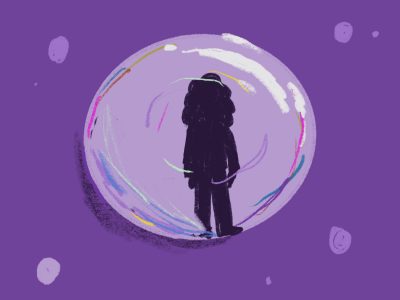In my head, I mapped out how the scenario at hand would make for the perfect show. It had all the key elements: an unusual environment, teenagers that fit different stereotypes, villains and unlikely bonds. 
The one-on-one interviews of characters from “Modern Family” and “The Office” could even be replicated when patients were pulled into rooms for their evaluations, serving as a brief inside look into the dynamics of the scene.
The characters of this particular show had challenging backstories, comedic one-liners and heartwarming tales of perseverance. I can hear the laugh track from off the stage with each joke about what our therapist said during our last session or how our drug tests weren’t coming back clean.
I can see the script of what to say during group therapy, what my mood rating was, and a feeling word to describe my day. I get back my notes in the form of dialectical behavior therapy worksheets. The director is instructing me to color pages of smiley faces and listen to the music therapist strumming his guitar, all while practicing mindfulness.
Stepping into the mental health treatment facility is a lot like stepping into a bubble. Here, we are patients, but to me, we become characters. Our phones are locked away in a room, cutting contact with the outside world, and we must ask permission to do anything.
It’s a sterile environment that is run by strict rules and keen techs to moderate the day-to-day discourse. Traditional education is put on the back burner, and instead we learn skills to better our mental health.
The best way I can describe it is that it’s like learning how to be a person all over again. How to care for yourself, how to talk to people, how to be alive. These are the roles we take.
Routine is everything in the bubble. A bit of schoolwork in the morning, lunch, group therapy, a small break, more group therapy, a third group for patients who need extra help or free time for those who don’t. We have meetings with our assigned therapist and psychiatrist for our treatment plans. All of this is done to ensure the bubble doesn’t pop and the characters stay on course.
The rooms of the facility are all clinical and feel like a constructed film set. Each one avoids displaying too much personality. The common room resembles the playrooms of hospitals with board games that have missing pieces, fraying puzzles and bent cards. There’s a television where only PG movies and shows from our childhood play. Therapists’ offices have stiff couches and cliche positivity posters.
Psychiatrists’ offices have decor so common it could be straight out of an IKEA showroom. Schoolrooms have bookshelves with unrecognizable titles that resemble props. This is where the characters’ personas project onto the bubble and spin it into a show.
I found a group of people who bonded with me over shared troubles. In our breaks, we congregated around tables and whispered about how we ended up here in the first place or the drama that was happening in the “real world.”
This is the enticing part of the show — this is how we break the rules. We are not allowed to exchange contact information or talk about our personal lives, but we do it anyway. Bonds are best formed when you share stories of your lives with each other, similar to the way shows are best made when you can feel the heart of the characters.
These are the best scenes of the show, they are the moments when the camera rolls.
We bring microwavable popcorn to snack on while watching episodes of “VeggieTales.”
We trade lunches. During music therapy, we sing karaoke to “Before He Cheats” and “Determinate” from “Lemonade Mouth.”
We get drug tested in groups and exit the bathroom hiding the cups of specimens up our sleeves so the rest don’t catch a glimpse and then laugh about it afterwards.
We bring stuffed animals to hold during group therapy and share fidget toys while learning DBT skills.
We pass notes about the techs and decorate our DBT binders. During breaks, games are played and the temporary feeling of community is strong.
To know that people are battling similar obstacles and surviving is powerful knowledge. To watch people get stronger and healthier in front of you is a motivating factor.
When I reflect on my time in the bubble I think of it as a “dramedy” about the lives of teenagers who became patients and had to start from scratch. It’s a fantasy that paints the darker themes of the facility in a different light. But through the lens of the imaginary show, every scene contributed to recovery.





















































































































